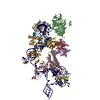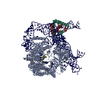+ Open data
Open data
- Basic information
Basic information
| Entry | Database: PDB / ID: 7v99 | ||||||
|---|---|---|---|---|---|---|---|
| Title | catalytic core of human telomerase holoenzyme | ||||||
 Components Components |
| ||||||
 Keywords Keywords | REPLICATION / Telomerase | ||||||
| Function / homology |  Function and homology information Function and homology informationpositive regulation of hair cycle / template-free RNA nucleotidyltransferase activity / positive regulation of transdifferentiation / TERT-RMRP complex / DNA strand elongation / RNA-directed RNA polymerase complex / siRNA transcription / positive regulation of protein localization to nucleolus / telomerase catalytic core complex / RNA-templated DNA biosynthetic process ...positive regulation of hair cycle / template-free RNA nucleotidyltransferase activity / positive regulation of transdifferentiation / TERT-RMRP complex / DNA strand elongation / RNA-directed RNA polymerase complex / siRNA transcription / positive regulation of protein localization to nucleolus / telomerase catalytic core complex / RNA-templated DNA biosynthetic process / establishment of protein localization to telomere / telomerase activity / Regulation of MITF-M-dependent genes involved in DNA replication, damage repair and senescence / siRNA processing / nuclear telomere cap complex / telomere maintenance via recombination / positive regulation of vascular associated smooth muscle cell migration / telomerase holoenzyme complex / telomerase RNA binding / DNA biosynthetic process / RNA-templated transcription / positive regulation of stem cell proliferation / telomeric DNA binding / mitochondrial nucleoid / negative regulation of cellular senescence / replicative senescence / Telomere Extension By Telomerase / negative regulation of extrinsic apoptotic signaling pathway in absence of ligand / positive regulation of G1/S transition of mitotic cell cycle / response to cadmium ion / positive regulation of Wnt signaling pathway / positive regulation of protein binding / negative regulation of endothelial cell apoptotic process / telomere maintenance via telomerase / protein localization to CENP-A containing chromatin / positive regulation of vascular associated smooth muscle cell proliferation / Replacement of protamines by nucleosomes in the male pronucleus / CENP-A containing nucleosome / Packaging Of Telomere Ends / Recognition and association of DNA glycosylase with site containing an affected purine / Cleavage of the damaged purine / Deposition of new CENPA-containing nucleosomes at the centromere / Recognition and association of DNA glycosylase with site containing an affected pyrimidine / Cleavage of the damaged pyrimidine / telomere maintenance / RNA Polymerase I Promoter Opening / Inhibition of DNA recombination at telomere / Assembly of the ORC complex at the origin of replication / Meiotic synapsis / Regulation of endogenous retroelements by the Human Silencing Hub (HUSH) complex / DNA methylation / Condensation of Prophase Chromosomes / Chromatin modifications during the maternal to zygotic transition (MZT) / SIRT1 negatively regulates rRNA expression / HCMV Late Events / ERCC6 (CSB) and EHMT2 (G9a) positively regulate rRNA expression / PRC2 methylates histones and DNA / innate immune response in mucosa / positive regulation of D-glucose import across plasma membrane / Regulation of endogenous retroelements by KRAB-ZFP proteins / Defective pyroptosis / mitochondrion organization / HDACs deacetylate histones / Regulation of endogenous retroelements by Piwi-interacting RNAs (piRNAs) / Nonhomologous End-Joining (NHEJ) / RNA Polymerase I Promoter Escape / Transcriptional regulation by small RNAs / Formation of the beta-catenin:TCF transactivating complex / Activated PKN1 stimulates transcription of AR (androgen receptor) regulated genes KLK2 and KLK3 / RUNX1 regulates genes involved in megakaryocyte differentiation and platelet function / G2/M DNA damage checkpoint / PML body / NoRC negatively regulates rRNA expression / regulation of protein stability / B-WICH complex positively regulates rRNA expression / DNA Damage/Telomere Stress Induced Senescence / positive regulation of miRNA transcription / Pre-NOTCH Transcription and Translation / Meiotic recombination / RNA-directed DNA polymerase / transcription coactivator binding / Metalloprotease DUBs / Activation of anterior HOX genes in hindbrain development during early embryogenesis / RMTs methylate histone arginines / Transcriptional regulation of granulopoiesis / RNA-directed DNA polymerase activity / positive regulation of angiogenesis / protein import into nucleus / HCMV Early Events / antimicrobial humoral immune response mediated by antimicrobial peptide / structural constituent of chromatin / UCH proteinases / antibacterial humoral response / heterochromatin formation / nucleosome / E3 ubiquitin ligases ubiquitinate target proteins / Recruitment and ATM-mediated phosphorylation of repair and signaling proteins at DNA double strand breaks / protein-folding chaperone binding / HATs acetylate histones / heart development Similarity search - Function | ||||||
| Biological species |  Homo sapiens (human) Homo sapiens (human) | ||||||
| Method | ELECTRON MICROSCOPY / single particle reconstruction / cryo EM / Resolution: 3.54 Å | ||||||
 Authors Authors | Wan, F. / Ding, Y. / Yang, L. / Wu, Z. / Wu, J. / Lei, M. | ||||||
| Funding support |  China, 1items China, 1items
| ||||||
 Citation Citation |  Journal: Cell Res / Year: 2021 Journal: Cell Res / Year: 2021Title: Zipper head mechanism of telomere synthesis by human telomerase. Authors: Futang Wan / Yongbo Ding / Yuebin Zhang / Zhenfang Wu / Shaobai Li / Lin Yang / Xiangyu Yan / Pengfei Lan / Guohui Li / Jian Wu / Ming Lei /  Abstract: Telomerase, a multi-subunit ribonucleoprotein complex, is a unique reverse transcriptase that catalyzes the processive addition of a repeat sequence to extend the telomere end using a short fragment ...Telomerase, a multi-subunit ribonucleoprotein complex, is a unique reverse transcriptase that catalyzes the processive addition of a repeat sequence to extend the telomere end using a short fragment of its own RNA component as the template. Despite recent structural characterizations of human and Tetrahymena telomerase, it is still a mystery how telomerase repeatedly uses its RNA template to synthesize telomeric DNA. Here, we report the cryo-EM structure of human telomerase holoenzyme bound with telomeric DNA at resolutions of 3.5 Å and 3.9 Å for the catalytic core and biogenesis module, respectively. The structure reveals that a leucine residue Leu980 in telomerase reverse transcriptase (TERT) catalytic subunit functions as a zipper head to limit the length of the short primer-template duplex in the active center. Moreover, our structural and computational analyses suggest that TERT and telomerase RNA (hTR) are organized to harbor a preformed active site that can accommodate short primer-template duplex substrates for catalysis. Furthermore, our findings unveil a double-fingers architecture in TERT that ensures nucleotide addition processivity of human telomerase. We propose that the zipper head Leu980 is a structural determinant for the sequence-based pausing signal of DNA synthesis that coincides with the RNA element-based physical template boundary. Functional analyses unveil that the non-glycine zipper head plays an essential role in both telomerase repeat addition processivity and telomere length homeostasis. In addition, we also demonstrate that this zipper head mechanism is conserved in all eukaryotic telomerases. Together, our study provides an integrated model for telomerase-mediated telomere synthesis. | ||||||
| History |
|
- Structure visualization
Structure visualization
| Structure viewer | Molecule:  Molmil Molmil Jmol/JSmol Jmol/JSmol |
|---|
- Downloads & links
Downloads & links
- Download
Download
| PDBx/mmCIF format |  7v99.cif.gz 7v99.cif.gz | 340 KB | Display |  PDBx/mmCIF format PDBx/mmCIF format |
|---|---|---|---|---|
| PDB format |  pdb7v99.ent.gz pdb7v99.ent.gz | 261.5 KB | Display |  PDB format PDB format |
| PDBx/mmJSON format |  7v99.json.gz 7v99.json.gz | Tree view |  PDBx/mmJSON format PDBx/mmJSON format | |
| Others |  Other downloads Other downloads |
-Validation report
| Summary document |  7v99_validation.pdf.gz 7v99_validation.pdf.gz | 828.7 KB | Display |  wwPDB validaton report wwPDB validaton report |
|---|---|---|---|---|
| Full document |  7v99_full_validation.pdf.gz 7v99_full_validation.pdf.gz | 849.3 KB | Display | |
| Data in XML |  7v99_validation.xml.gz 7v99_validation.xml.gz | 41 KB | Display | |
| Data in CIF |  7v99_validation.cif.gz 7v99_validation.cif.gz | 64 KB | Display | |
| Arichive directory |  https://data.pdbj.org/pub/pdb/validation_reports/v9/7v99 https://data.pdbj.org/pub/pdb/validation_reports/v9/7v99 ftp://data.pdbj.org/pub/pdb/validation_reports/v9/7v99 ftp://data.pdbj.org/pub/pdb/validation_reports/v9/7v99 | HTTPS FTP |
-Related structure data
| Related structure data |  31811MC  7v9aC M: map data used to model this data C: citing same article ( |
|---|---|
| Similar structure data | Similarity search - Function & homology  F&H Search F&H Search |
- Links
Links
- Assembly
Assembly
| Deposited unit | 
|
|---|---|
| 1 |
|
- Components
Components
| #1: Protein | Mass: 127195.812 Da / Num. of mol.: 1 / Source method: isolated from a natural source / Source: (natural)  Homo sapiens (human) / References: UniProt: O14746, RNA-directed DNA polymerase Homo sapiens (human) / References: UniProt: O14746, RNA-directed DNA polymerase |
|---|---|
| #2: Protein | Mass: 14034.355 Da / Num. of mol.: 1 / Source method: isolated from a natural source / Source: (natural)  Homo sapiens (human) / References: UniProt: P04908 Homo sapiens (human) / References: UniProt: P04908 |
| #3: Protein | Mass: 13790.018 Da / Num. of mol.: 1 / Source method: isolated from a natural source / Source: (natural)  Homo sapiens (human) / References: UniProt: O60814 Homo sapiens (human) / References: UniProt: O60814 |
| #4: RNA chain | Mass: 145477.797 Da / Num. of mol.: 1 / Source method: isolated from a natural source / Source: (natural)  Homo sapiens (human) / References: GenBank: 1932797 Homo sapiens (human) / References: GenBank: 1932797 |
| #5: DNA chain | Mass: 7339.724 Da / Num. of mol.: 1 / Source method: obtained synthetically / Source: (synth.)  Homo sapiens (human) Homo sapiens (human) |
| Has protein modification | Y |
-Experimental details
-Experiment
| Experiment | Method: ELECTRON MICROSCOPY |
|---|---|
| EM experiment | Aggregation state: PARTICLE / 3D reconstruction method: single particle reconstruction |
- Sample preparation
Sample preparation
| Component | Name: Catalytic core / Type: COMPLEX / Entity ID: all / Source: MULTIPLE SOURCES |
|---|---|
| Source (natural) | Organism:  Homo sapiens (human) Homo sapiens (human) |
| Buffer solution | pH: 7.9 |
| Specimen | Embedding applied: NO / Shadowing applied: NO / Staining applied: NO / Vitrification applied: YES |
| Vitrification | Cryogen name: ETHANE |
- Electron microscopy imaging
Electron microscopy imaging
| Experimental equipment |  Model: Titan Krios / Image courtesy: FEI Company |
|---|---|
| Microscopy | Model: FEI TITAN KRIOS |
| Electron gun | Electron source:  FIELD EMISSION GUN / Accelerating voltage: 300 kV / Illumination mode: FLOOD BEAM FIELD EMISSION GUN / Accelerating voltage: 300 kV / Illumination mode: FLOOD BEAM |
| Electron lens | Mode: BRIGHT FIELD |
| Image recording | Electron dose: 62 e/Å2 / Film or detector model: GATAN K3 (6k x 4k) |
- Processing
Processing
| CTF correction | Type: PHASE FLIPPING AND AMPLITUDE CORRECTION |
|---|---|
| 3D reconstruction | Resolution: 3.54 Å / Resolution method: FSC 0.143 CUT-OFF / Num. of particles: 297526 / Symmetry type: POINT |
 Movie
Movie Controller
Controller






 PDBj
PDBj



































































